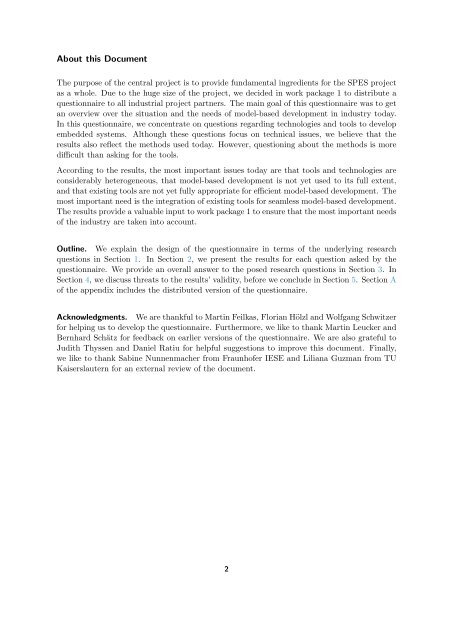SPES 2020 Deliverable 1.4.B-1 Result of the Tool Questionnaire
SPES 2020 Deliverable 1.4.B-1 Result of the Tool Questionnaire
SPES 2020 Deliverable 1.4.B-1 Result of the Tool Questionnaire
Create successful ePaper yourself
Turn your PDF publications into a flip-book with our unique Google optimized e-Paper software.
About this Document<br />
The purpose <strong>of</strong> <strong>the</strong> central project is to provide fundamental ingredients for <strong>the</strong> <strong>SPES</strong> project<br />
as a whole. Due to <strong>the</strong> huge size <strong>of</strong> <strong>the</strong> project, we decided in work package 1 to distribute a<br />
questionnaire to all industrial project partners. The main goal <strong>of</strong> this questionnaire was to get<br />
an overview over <strong>the</strong> situation and <strong>the</strong> needs <strong>of</strong> model-based development in industry today.<br />
In this questionnaire, we concentrate on questions regarding technologies and tools to develop<br />
embedded systems. Although <strong>the</strong>se questions focus on technical issues, we believe that <strong>the</strong><br />
results also reflect <strong>the</strong> methods used today. However, questioning about <strong>the</strong> methods is more<br />
difficult than asking for <strong>the</strong> tools.<br />
According to <strong>the</strong> results, <strong>the</strong> most important issues today are that tools and technologies are<br />
considerably heterogeneous, that model-based development is not yet used to its full extent,<br />
and that existing tools are not yet fully appropriate for efficient model-based development. The<br />
most important need is <strong>the</strong> integration <strong>of</strong> existing tools for seamless model-based development.<br />
The results provide a valuable input to work package 1 to ensure that <strong>the</strong> most important needs<br />
<strong>of</strong> <strong>the</strong> industry are taken into account.<br />
Outline. We explain <strong>the</strong> design <strong>of</strong> <strong>the</strong> questionnaire in terms <strong>of</strong> <strong>the</strong> underlying research<br />
questions in Section 1. In Section 2, we present <strong>the</strong> results for each question asked by <strong>the</strong><br />
questionnaire. We provide an overall answer to <strong>the</strong> posed research questions in Section 3. In<br />
Section 4, we discuss threats to <strong>the</strong> results’ validity, before we conclude in Section 5. Section A<br />
<strong>of</strong> <strong>the</strong> appendix includes <strong>the</strong> distributed version <strong>of</strong> <strong>the</strong> questionnaire.<br />
Acknowledgments. We are thankful to Martin Feilkas, Florian Hölzl and Wolfgang Schwitzer<br />
for helping us to develop <strong>the</strong> questionnaire. Fur<strong>the</strong>rmore, we like to thank Martin Leucker and<br />
Bernhard Schätz for feedback on earlier versions <strong>of</strong> <strong>the</strong> questionnaire. We are also grateful to<br />
Judith Thyssen and Daniel Ratiu for helpful suggestions to improve this document. Finally,<br />
we like to thank Sabine Nunnenmacher from Fraunh<strong>of</strong>er IESE and Liliana Guzman from TU<br />
Kaiserslautern for an external review <strong>of</strong> <strong>the</strong> document.<br />
2
















